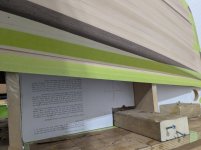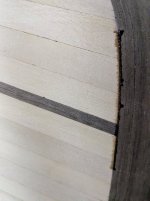that contrast between the woods looks fantastic! Great looking work, and great choice matching and blending the outer stems with the dark strips. I can't wait to see it glassed and finished and in the water!
-
Happy National Pickle Day! 🥒
You are using an out of date browser. It may not display this or other websites correctly.
You should upgrade or use an alternative browser.
You should upgrade or use an alternative browser.
Kite +6%
- Thread starter BigandSmall
- Start date
Shaved the epoxy down with the scraper then went over everything again with 180 grit.
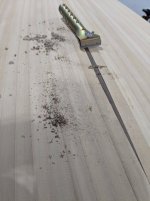
Vacuumed the hull twice then hit it with the tack cloth before seal coating. I really enjoyed the colour reveal.



When the epoxy went on I saw a couple of spots I'll have to sand again. I didn't sand it enough the first time and the glue prevented the epoxy from soaking in.
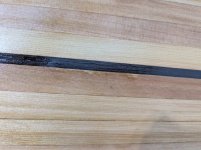
I was happy with how the filler I mixed up turned out colour wise. It's hard to see unless you look really close.


Vacuumed the hull twice then hit it with the tack cloth before seal coating. I really enjoyed the colour reveal.



When the epoxy went on I saw a couple of spots I'll have to sand again. I didn't sand it enough the first time and the glue prevented the epoxy from soaking in.

I was happy with how the filler I mixed up turned out colour wise. It's hard to see unless you look really close.

I forgot to add, when I seal coated I did my best to brush on a very thin even coat tipping back into the wet. You could really see the sections where it sucked up the epoxy (flat spots) and the areas where it didn't (shiny). Hopefully it saves some weight.
- Joined
- Aug 9, 2025
- Messages
- 69
- Reaction score
- 158
So looks forward to the next step ..i hope you nail the glassing. You are on the way to a really great canoe
This boat looks awesome! I’ve enjoyed following along.
A tip I often share, when applying epoxy.
Check your seal coat, before laying down the cloth. Anything on the surface, that you can feel, such as dust imbedded in the epoxy, must be removed. I Scrape with a razor blade, don't sand.
If left, those particles will lift the cloth away from the hull. Creating a high spot. Not good when you sand !
One more tip.
Apply the wet out coat and let it cure, 3 to 4 hours, make sure the cloth is stuck to the hull, and won't move, when you add fill coats.
Add fill coats, while the previous coat is still Tacky.
This greatly reduces runs. This works.
Take it from a guy, that has scraped far too many runs in his life !
The Best of luck glassing !
Jim
PS. Your hull looks great! the seal coat will make wetting out the cloth go faster. OH, Don't walk away, after wetting out the cloth. Out gassing is your worst enemy. Bubbles will pop up when you walk away !!!
Check your seal coat, before laying down the cloth. Anything on the surface, that you can feel, such as dust imbedded in the epoxy, must be removed. I Scrape with a razor blade, don't sand.
If left, those particles will lift the cloth away from the hull. Creating a high spot. Not good when you sand !
One more tip.
Apply the wet out coat and let it cure, 3 to 4 hours, make sure the cloth is stuck to the hull, and won't move, when you add fill coats.
Add fill coats, while the previous coat is still Tacky.
This greatly reduces runs. This works.
Take it from a guy, that has scraped far too many runs in his life !
The Best of luck glassing !
Jim
PS. Your hull looks great! the seal coat will make wetting out the cloth go faster. OH, Don't walk away, after wetting out the cloth. Out gassing is your worst enemy. Bubbles will pop up when you walk away !!!
Yeow!!
That's gonna be too pretty to paddle...
That's gonna be too pretty to paddle...
Just looking better and better! Great work.
Thanks for the kind words guys. I want to let it cure for a few days before gently sanding it. I want to be really careful not to get any dust trapped in green epoxy so I'll wait on sanding. I'll need 12-13 hours for 3 coats of West Systems 105/207 so it will likely be the 14th for glass unless I pick up extra shifts.
I hear you on the runs Jim. I now set an alarm and walk round and round tipping of any surprises and ensuring everything is laying flat.
I hear you on the runs Jim. I now set an alarm and walk round and round tipping of any surprises and ensuring everything is laying flat.
Sanding creates dust.
Consider scraping. You can scrape after the epoxy cures, say 12 hrs. but sanding you want to wait, until full cure. Uncured epoxy in the lings is not good.
Sounds like a good plan for you epoxy schedule.
Jim
Consider scraping. You can scrape after the epoxy cures, say 12 hrs. but sanding you want to wait, until full cure. Uncured epoxy in the lings is not good.
Sounds like a good plan for you epoxy schedule.
Jim
My plan is to wait a few more days to sand. Then I'll give it a wash first with water cloth then a gentle sand again with 180 grit on the log board and a little with the RO plus some by hand. This will be followed but a couple passes with the vacuum, another water wet wipe followed by a tack cloth. Maybe it's the scrapers I use but I don't get an even finish with them.
I'll go try the scraper today Jim and see how it goes. Where I started I did a great job keeping it thin but after the first 4 feet I see I was too generous with the application.
I'll go try the scraper today Jim and see how it goes. Where I started I did a great job keeping it thin but after the first 4 feet I see I was too generous with the application.
No water is needed. A vacuum does just fine. A Tack cloth could introduce contaminates.
Now that you have waited. Yes sand. Wear a good dust mask to save your health.
Again, no water or tack cloth. Vacuum yes.
Looking forward to hear and see the results !
Jim
Now that you have waited. Yes sand. Wear a good dust mask to save your health.
Again, no water or tack cloth. Vacuum yes.
Looking forward to hear and see the results !
Jim
The warm water wipe down is just to remove any potential amine blush. I do this before I start sanding as I've read you'll sand/mix it in if there's any there. The tack cloths I have are sealed in packages and leave no lint. Even after scrubbing at it twice with the vacuum the tack cloth will still pick up a bunch of residual sawdust. The colour change was surprising prior to the seal coat as it grabbed walnut/cedar dust and turned from yellow to beige. I appreciate the tips Jim. I always wear a double cartridge respirator. Dust for sanding and organic vapour for epoxy work.
I tried scraping at the seal coat for a few hours the other day. It certainly allows you to take it right down. I put in a new blade in my scraper and it did well shaving. I ended up stopping after just doing the bottom bit on one side. Might have been user error but I ended up hitting wood in a few spots on the rounded bits. I also left a good gouge where I made some spots that weren't level from the random orbital. The long board worked so well I can't believe I've gotten by this long without one. I'm sure I removed more material with the scraping but I prefer the long board. In the first pic you can see the left side sanded and the right side scraped. I got most of the hull done today and was able to clean up the big gouge I made. I'll get the bow and stern sections with the random orbital as the long board doesn't work great there. I still need to get to the tumblehome sections. Still hoping for the 14th for glass.



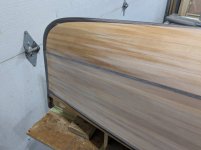
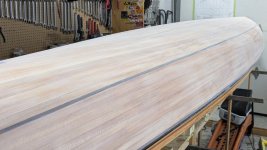
I tried scraping at the seal coat for a few hours the other day. It certainly allows you to take it right down. I put in a new blade in my scraper and it did well shaving. I ended up stopping after just doing the bottom bit on one side. Might have been user error but I ended up hitting wood in a few spots on the rounded bits. I also left a good gouge where I made some spots that weren't level from the random orbital. The long board worked so well I can't believe I've gotten by this long without one. I'm sure I removed more material with the scraping but I prefer the long board. In the first pic you can see the left side sanded and the right side scraped. I got most of the hull done today and was able to clean up the big gouge I made. I'll get the bow and stern sections with the random orbital as the long board doesn't work great there. I still need to get to the tumblehome sections. Still hoping for the 14th for glass.





Similar threads
- Replies
- 13
- Views
- 2K
- Replies
- 30
- Views
- 3K
- Replies
- 44
- Views
- 4K

